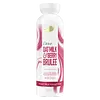What's inside
What's inside
 Key Ingredients
Key Ingredients

 Benefits
Benefits

 Concerns
Concerns

 Ingredients Side-by-side
Ingredients Side-by-side

Water
Skin ConditioningCocamidopropyl Betaine
CleansingGlycerin
HumectantParfum
MaskingSodium Benzoate
MaskingSodium Methyl Lauroyl Taurate
CleansingSodium Lauroyl Isethionate
CleansingAcrylates Copolymer
Sodium Chloride
MaskingLauric Acid
CleansingHydroxystearic Acid
CleansingStearic Acid
CleansingPalmitic Acid
EmollientGlyceryl Stearate
EmollientAvena Sativa Kernel Extract
AbrasiveRubus Idaeus Fruit Extract
AstringentGlycol Distearate
EmollientCocamide Mea
EmulsifyingCaramel
Cosmetic ColorantCitric Acid
BufferingCyanocobalamin
Skin ConditioningGardenia Florida Fruit Extract
Skin ConditioningPPG-9
Skin ConditioningCapryloyl Glycine
CleansingUndecylenoyl Glycine
CleansingLimonene
PerfumingLinalool
PerfumingWater, Cocamidopropyl Betaine, Glycerin, Parfum, Sodium Benzoate, Sodium Methyl Lauroyl Taurate, Sodium Lauroyl Isethionate, Acrylates Copolymer, Sodium Chloride, Lauric Acid, Hydroxystearic Acid, Stearic Acid, Palmitic Acid, Glyceryl Stearate, Avena Sativa Kernel Extract, Rubus Idaeus Fruit Extract, Glycol Distearate, Cocamide Mea, Caramel, Citric Acid, Cyanocobalamin, Gardenia Florida Fruit Extract, PPG-9, Capryloyl Glycine, Undecylenoyl Glycine, Limonene, Linalool
Ingredients Explained
These ingredients are found in both products.
Ingredients higher up in an ingredient list are typically present in a larger amount.
Parfum is a catch-all term for an ingredient or more that is used to give a scent to products.
Also called "fragrance", this ingredient can be a blend of hundreds of chemicals or plant oils. This means every product with "fragrance" or "parfum" in the ingredients list is a different mixture.
For instance, Habanolide is a proprietary trade name for a specific aroma chemical. When used as a fragrance ingredient in cosmetics, most aroma chemicals fall under the broad labeling category of “FRAGRANCE” or “PARFUM” according to EU and US regulations.
The term 'parfum' or 'fragrance' is not regulated in many countries. In many cases, it is up to the brand to define this term.
For instance, many brands choose to label themselves as "fragrance-free" because they are not using synthetic fragrances. However, their products may still contain ingredients such as essential oils that are considered a fragrance by INCI standards.
One example is Calendula flower extract. Calendula is an essential oil that still imparts a scent or 'fragrance'.
Depending on the blend, the ingredients in the mixture can cause allergies and sensitivities on the skin. Some ingredients that are known EU allergens include linalool and citronellol.
Parfum can also be used to mask or cover an unpleasant scent.
The bottom line is: not all fragrances/parfum/ingredients are created equally. If you are worried about fragrances, we recommend taking a closer look at an ingredient. And of course, we always recommend speaking with a professional.
Learn more about ParfumChances are, you eat sodium chloride every day. Sodium Chloride is also known as table salt.
This ingredient has many purposes in skincare: thickener, emulsifier, and exfoliator.
You'll most likely find this ingredient in cleansers where it is used to create a gel-like texture. As an emulsifier, it also prevents ingredients from separating.
There is much debate on whether this ingredient is comedogenic. The short answer - comedogenic ratings don't tell the whole story. Learn more about comegodenic ratings here.
The concensus about this ingredient causing acne seems to be divided. Research is needed to understand if this ingredient does cause acne.
Scrubs may use salt as the primary exfoliating ingredient.
Learn more about Sodium Chloride